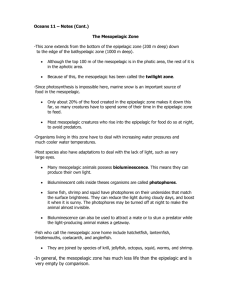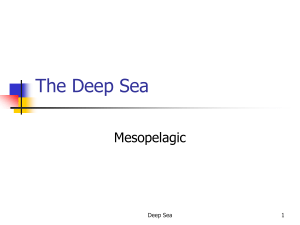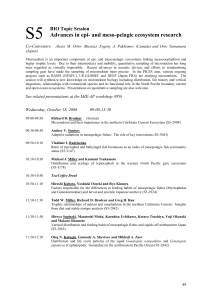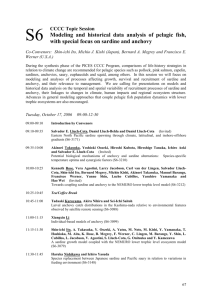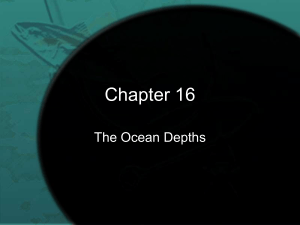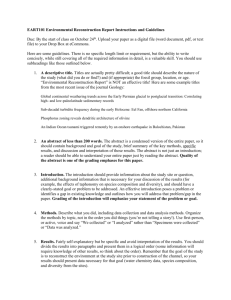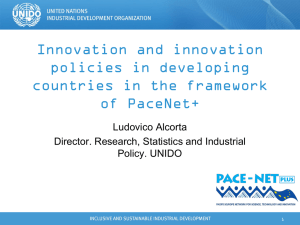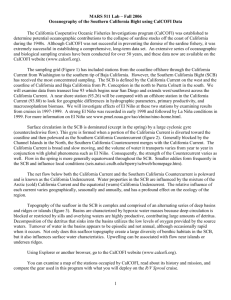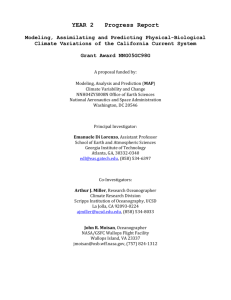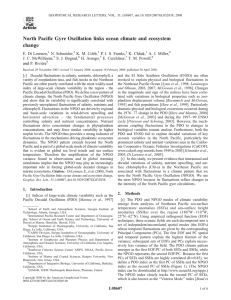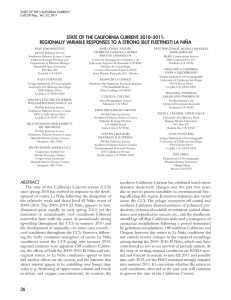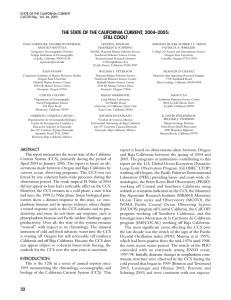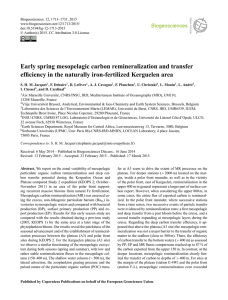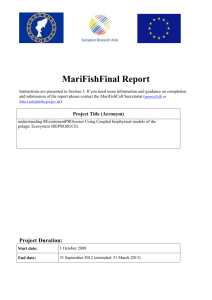Koslow_Summary - PICES WG27 North Pacific Climate
advertisement
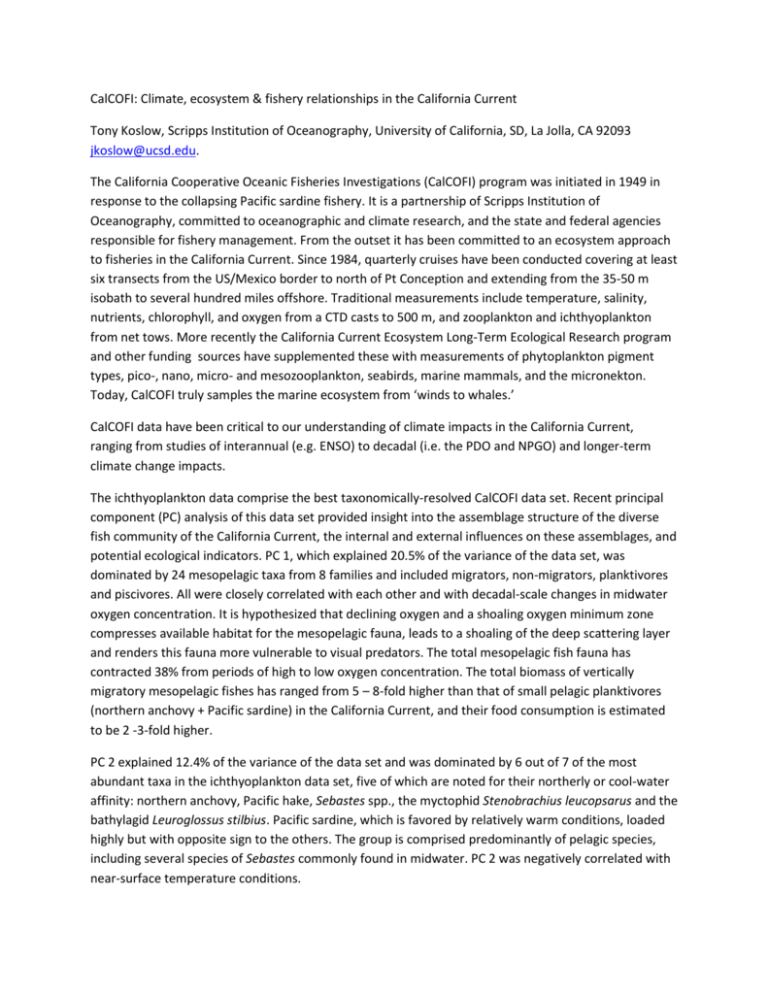
CalCOFI: Climate, ecosystem & fishery relationships in the California Current Tony Koslow, Scripps Institution of Oceanography, University of California, SD, La Jolla, CA 92093 jkoslow@ucsd.edu. The California Cooperative Oceanic Fisheries Investigations (CalCOFI) program was initiated in 1949 in response to the collapsing Pacific sardine fishery. It is a partnership of Scripps Institution of Oceanography, committed to oceanographic and climate research, and the state and federal agencies responsible for fishery management. From the outset it has been committed to an ecosystem approach to fisheries in the California Current. Since 1984, quarterly cruises have been conducted covering at least six transects from the US/Mexico border to north of Pt Conception and extending from the 35-50 m isobath to several hundred miles offshore. Traditional measurements include temperature, salinity, nutrients, chlorophyll, and oxygen from a CTD casts to 500 m, and zooplankton and ichthyoplankton from net tows. More recently the California Current Ecosystem Long-Term Ecological Research program and other funding sources have supplemented these with measurements of phytoplankton pigment types, pico-, nano, micro- and mesozooplankton, seabirds, marine mammals, and the micronekton. Today, CalCOFI truly samples the marine ecosystem from ‘winds to whales.’ CalCOFI data have been critical to our understanding of climate impacts in the California Current, ranging from studies of interannual (e.g. ENSO) to decadal (i.e. the PDO and NPGO) and longer-term climate change impacts. The ichthyoplankton data comprise the best taxonomically-resolved CalCOFI data set. Recent principal component (PC) analysis of this data set provided insight into the assemblage structure of the diverse fish community of the California Current, the internal and external influences on these assemblages, and potential ecological indicators. PC 1, which explained 20.5% of the variance of the data set, was dominated by 24 mesopelagic taxa from 8 families and included migrators, non-migrators, planktivores and piscivores. All were closely correlated with each other and with decadal-scale changes in midwater oxygen concentration. It is hypothesized that declining oxygen and a shoaling oxygen minimum zone compresses available habitat for the mesopelagic fauna, leads to a shoaling of the deep scattering layer and renders this fauna more vulnerable to visual predators. The total mesopelagic fish fauna has contracted 38% from periods of high to low oxygen concentration. The total biomass of vertically migratory mesopelagic fishes has ranged from 5 – 8-fold higher than that of small pelagic planktivores (northern anchovy + Pacific sardine) in the California Current, and their food consumption is estimated to be 2 -3-fold higher. PC 2 explained 12.4% of the variance of the data set and was dominated by 6 out of 7 of the most abundant taxa in the ichthyoplankton data set, five of which are noted for their northerly or cool-water affinity: northern anchovy, Pacific hake, Sebastes spp., the myctophid Stenobrachius leucopsarus and the bathylagid Leuroglossus stilbius. Pacific sardine, which is favored by relatively warm conditions, loaded highly but with opposite sign to the others. The group is comprised predominantly of pelagic species, including several species of Sebastes commonly found in midwater. PC 2 was negatively correlated with near-surface temperature conditions. PC 3 explained 6.8% of the variance of the data set and was dominated by coastal species with generally warm-water affinities, including tonguefish (Symphurus atricaudus), blacksmith (Chromis punctipinnis), Pacific barracuda (Sphyraena argentea), cuskeels (Ophidion scrippsae, Chilara taylori), blennies, (Hypsoblennius spp.), sciaenids, and sand dabs (Citharichthys spp.). This group was favored by warmwater conditions. PC 2 and PC 3 correspond closely with the northerly and southerly/coastal larval assemblages previously defined with recurrent group analysis on the basis of their spatial co-occurrence (Moser et al. 1987). The temporal coherence of these ‘habitat’/biogeographic-based assemblages indicates broad environmental forcing of assemblages sharing spatial habitat. These larval fish assemblages may thus serve as multidimensional ecosystem indicators of environmental change. There were generally positive correlations between mesopelagic fishes and key pelagic species: Pacific hake, northern anchovy, Pacific mackerel (Scomber japonicus), and horse mackerel (Trachurus symmetricus). Both mesopelagic and pelagic groups were generally correlated significantly with key ocean indices, such as the MEI, PDO, and NPGO. Correlations were generally positive with the MEI and PDO and negative with the NPGO, indicating that warm conditions with reduced upwelling were generally favorable. The consistent positive correlations among potential competitors, predators and prey indicate bottom-up forcing. The strong coherent response of the mesopelagic fishes to changing oxygen conditions indicates that this group may be a sensitive ecological indicator for deoxygenation, a key change predicted by several climate models.
